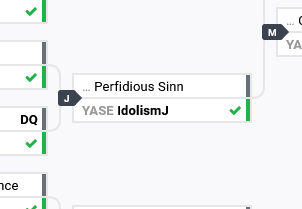The Age Of Content is fully in swing within the FGC. Between streaming on Twitch or making videos on YouTube, the avenues are readily available for us to inform and entertain those willing to tune in. But as much as this has ramped up within the past couple years, this doesn’t mean there weren’t people within the FGC who were early adopters for making fighting game content. Among those back then, my favorite group is Team Best From Now.
Yes, 15 years ago BFN was talking about Voltage Fighter Gowcaizer. I can’t think of many people who have talked about it since.
Team Best From Now, named after the botched English prompt in Dragon Master, were absolute kusoge lords. They have a variety of reviews for total poverty that wouldn’t get a re-evaluation for at least a decade. Nowadays, we have tournaments for games like Survival Arts and Double Dragon but here was Team Best From Now breaking down these games back in 2007. Their most widely-known video was an overview of Ivan Ooze from Mighty Morphin’ Power Rangers being omega broken, but for me the video I will always remember them for was about a game broken in a very different way.
Bananas confirmed top tier
Seifuku Densetsu Pretty Fighter, developed by fighting game-orbiter Genki, is a bishojo fighting game released on the SNES in 1994. 8 girls dolled up in commonly popular costuming fight it out for [insert reason here]. Shockingly, this is contemporaneous with a lot of the other big names in Bishoujo fighters, Variable Geo and Metal & Lace came out in 1993, Asuka 120% came out in 1994. The difference between Pretty Fighter and those titles is obvious however; Pretty Fighter sucks.
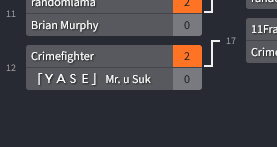
In hindsight it is incredibly on brand that the first time I would meet one of my close FGC friends Crimefighter (@A_Crimefighter) would be in a losing affair over Pretty Fighter at Combo Breaker 2015’s Mystery Tournament.
Not to claim that Metal & Lace is buried treasure, but it at least works (and I have a soft spot for Metal and Lace 2 on DOS). Pretty Fighter is missing the acceptable level of polish that would make the game playable. Like, it does move well enough. It has a level of speed and responsiveness that at first would make you think you are playing a competently made game, but as soon as you start engaging in combat it starts to fall apart. There are practically no combos in this game, as there are no chains and normals rarely have the frame data necessary to link off of them. There is also no pushback on block unless you are in the corner, so you can lock someone down pretty efficiently by rapid-firing your fastest normal on them if they block midscreen. Throws…don’t work. They exist, but they have the critical flaw of being blockable. This isn’t just for normal throws, but command grabs are also blockable. This makes Yawara garbage-tier as being the grappler in a game where all throws are blockable is a sorry path of life. Knockdowns work very strangely as well, instead of a standardized suite of moves that cause knockdown (ex: every cr.HK being a sweep knockdown) there is instead a hidden gauge that will cause a knockdown when it has been depleted. Think like an old school Street Fighter stun but instead of refilling over time it is a constant and if the meter depletes at the right moment you can knockdown someone off a light jab. Because of all of this Pretty Fighter just kinda feels like a game where you win by poking with your longest reaching and fasted button, it’s very janky and not particularly fun or playable.
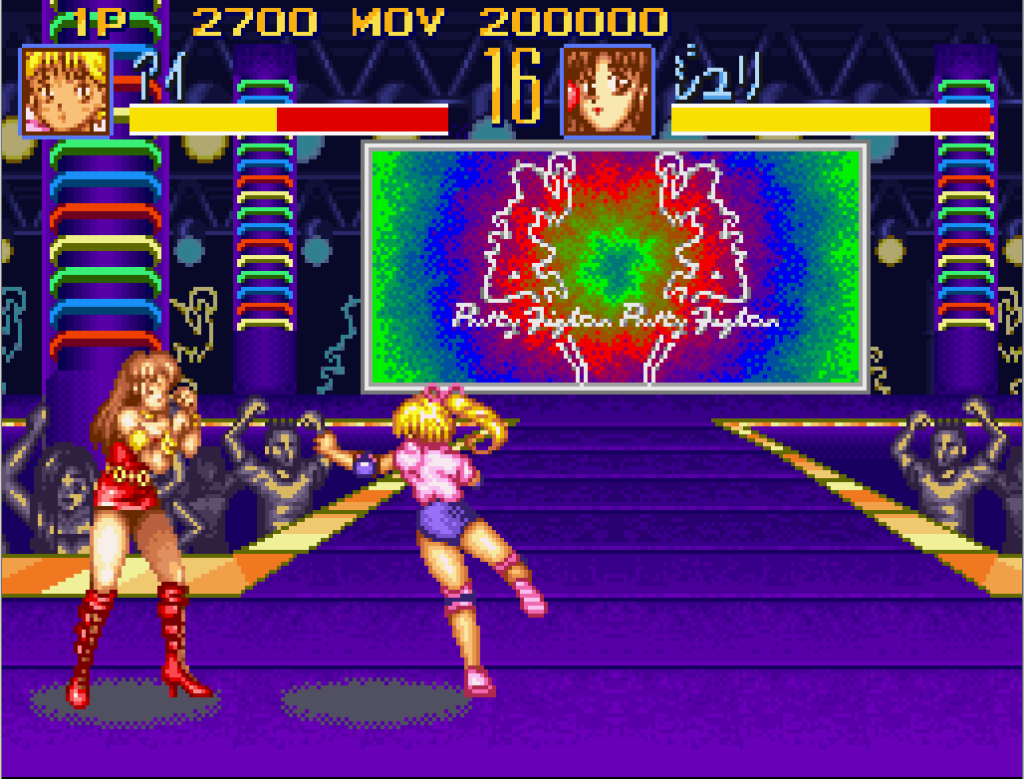
Okay I guess technically her name is Ai Momoyama, but she’ll always be Bananas to me.
My assumption is that Pretty Fighter was trying to succeed by being a fanservice fighter for the safe-for-work Super Famicom. It lacks the ability to sell sex the way Metal & Lace or Variable Geo did and it lacks the ability to, uh, be good the way Asuka 120% or Angel Eyes would soon offer. But the Super Famicom was large and popular and maybe people would bite on the idea of cute girls in sailor fukus, nurses uniforms, or athletic wear. Some translations of special moves show sexual innuendos at play as well. I assume that the game manual did the heavy lifting in fleshing out these characters, as additional information has been translated like occupations (most of which are obvious vis a vis their costumes), measurements (would you be surprised to hear almost every girl has an hourglass figure?), and dislikes (uh, Minami hates effeminate, cross-dressing gays. Not a good flex there, chief). I don’t think I can really call it ecchi as the game is so chaste in the depictions of their characters, especially given what else was being released around then.
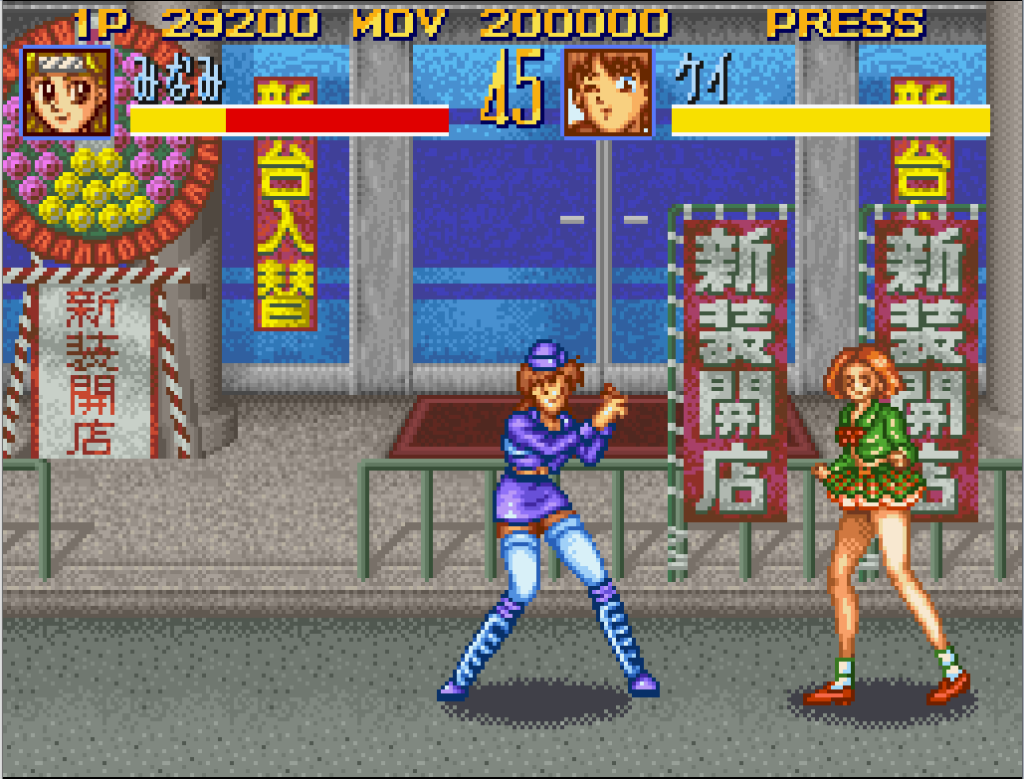
Pictured: Two bigots fighting.
This could easily be the end of the story here. Many a fighting game attempt is made, especially in the early 90s boom period, and many a failure happened in chasing the fortune Street Fighter 2 brought. It’s not like Tao Taido ever got a sequel. I was not able to find any sort of sales numbers or anything but Pretty Fighter at the very least did not bomb because the very next year the Sega Saturn was blessed with Seifuku Densetsu Pretty Fighter X. However Genki was not behind development this time around, instead Sol took control of making this release. Sol, who you would know from absolutely nothing, had most of their work cut out for them as Pretty Fighter X lies somewhere between a sequel and a remake.
Off the top, Pretty Fighter X fixes almost all the sins the original had. Normal throws and command grabs are no longer blockable, frame data has been adjusted to actually allow enough advantage for link combos, and special cancels have been introduced. This goes a long way in making Pretty Fighter X actually play like a fighting game. It still has its interesting wrinkles, like the way knockdowns work are still done via the hidden gauge, but you at least have sweeps now, and you can special cancel into a command grab and have it connect a la King of Fighters. The flip side to all these advancements is that Pretty Fighter X plays a little…sludgier. The speed has been noticeably tuned down from the original and for as much as it is now a infinitely better game by having actual working mechanics, it just “feels” worse to play. It’s a bit of a bummer because if Pretty Fighter X could keep that snappy pace of play it really could have been a decent little fighter. It’s still fine, and a far cry improvement over the original Pretty Fighter, but just a tinge sad that they couldn’t pull it all together.
Thankfully there is a side-by-side on YouTube to show the difference in game speed.
Cart technology is a thing of the past, baby! We now have CD-ROMs that have more storage than we know what to do with! So Pretty Fighter X redrew and digitized all the assets, added 4 new characters, and added bomb-ass anime FMV’s for characters’ story mode. I love these FMV’s, not only are they super 90s in a way I am horrifically nostalgic for but they let the game actually have a little ecchi, as a treat. The other graphical moves made don’t look as good, the new characters look like paper cutouts and animate with a robotic clunk attached to them. The backgrounds look like cheap garbo compared to the original sprite designs. Some examples, like the riverside stage, look like an uncanny photo collage with all the assets layering over each other in a perturbing manner.
I cannot lie, I am eating this 90s anime shit up. Especially under deep-fried compression.
But there was still one final frontier left unexplored. One potential market for the Pretty Fighter franchise to try and PG-13 (at best) its way into some money; 3D fighters. In 1996 (that’s three games in three years in a row if anyone is keeping track), the last game in the Pretty Fighter series would come home to the Sega Saturn: Fist. That’s it, no fancy subtitle, no association with Pretty Fighter other than two characters coming back, just Fist. With Genki back in the developers chair, and with help from Sol (more on this later), this tag team of fighting game elite developers was surely going to revolutionize the industry and put Virtua Fighter’s dusty ass out to pasture.
Now a 3D 3-button fighter in the Punch/Kick/Guard variety, Fist is just the most boneless Virtua Fighter knockoff. Large blocky character models with ugly backdrops and moonjumps that would make it feel right at home next to Virtua Fighter 1. Character’s move lists also feel slight and lacking in any particular expressions other than “this looks like a move from Tekken”, along with being filled with common attacks shared by others. You can launch your opponent and get a bit of a juggle going, but that’s about it. It’s not horrific, but being released on the console that had Virtua Fighter 2, Fighting Vipers, and Fighters Megamix leaves you with almost no reason whatsoever in picking this game up, there’s just nothing interesting about it. The closest thing I could find to a mechanic was that strings were made up of moves that animation cancel the attack previous, but in execution they seem to operate the same way a string normally would.
"Fist" – Arts Infinite
I got bored trying to recapture the 100% but rest assured it works. Arts can also do his PPP combo string as an ender since it's a natural combo.
Those links are pretty tight for how boring they look 😅 pic.twitter.com/EIgLuZllqm— Epsilon Eagle (@eagle_epsilon) August 17, 2021
Fist also came out on Ps1 where we get jab infinites, let’s go jab infinites I love da jab infinites.
It also ends up being the game with maybe the most obvious sense of where the budget went. If you look at the back of the box for Fist it becomes very apparent what the marketing ploy was. The seiyuu are proudly put front and center as the major attraction in Fist, and holy crap what a star-studded cast this was! Outside of Kikuko Inoue, who has a massive body of work by this point, most of these seiyuu were still early-ish into their careers. Atsuko Tanaka would become the voice of Ghost In The Shell’s Makoto Kusanagi, Akemi Okamura would become One Piece’s Nami alongside Ikue Ōtani who respectively played Chopper in One Piece and Ōtani also goes on to bring to life a pretty small mascot character (you’ve probably never heard of them) named motherfucking Pikachu. It’s shocking to see such eventually-titanesque names all performing together…for Fist.
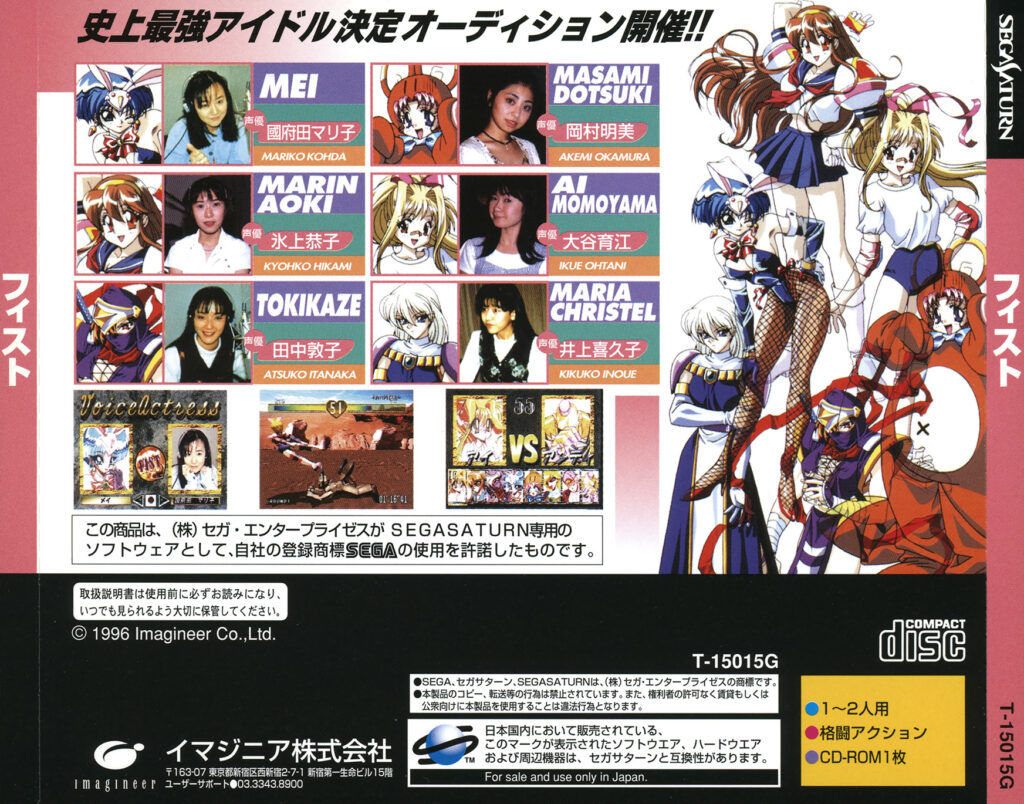
I for one am totally shocked that Fist is somehow missing on every single seiyuu’s wikipedia page.
But with that said; I think I like Fist. Mainly because the soundtrack is filled with absolute heaters. I can forgive a lot if the tunes are delicious and the songs in Fist are downright delectable. This Pop soundtrack has some of the best 90s vibes with its lovingly-dated MIDI horn sample melodies and electronic, but never overly-dancy, percussion. There is just enough groove to get your head moving, but never enough to distract from the cheery vibes the melodies give off. We are even blessed with two vocal themes, both of which go ridiculously hard and sound like (MAJOR CRINGE WARNING: TAKE COVER NOW) anime OPs to shows I would randomly stumble upon in the late 90s. Truthfully, this entire article was a psyop for getting you to listen to this soundtrack.
This sounds like Sonic Adventure 1. That’s a massive compliment coming from me; known Sonic Adventure 1 fanboy.
But alas, this ended the series as I can only assume Fist did not make enough of a splash. Once again, no way for me to figure out sales at the time but given what 3D fighters looked like at the time in 1996 Fist was so far below the standard. Fist came to home consoles within a month’s time of Tekken 3 and Virtua Fighter 3 making their first arcade showings, just think about the gap between those games in terms of quality. Genki would continue to make their flagship series Shotoko Battle/Tokyo Xtreme Racer, but did dip back into fighting games here and there. They helped out on both Fighters Destiny games on the N64, did the Virtua Fighter 3tb port for Dreamcast, and were the developers behind the infamous Kabuki Warriors for Xbox. Sol on the other hand has little else to their name, but if you are like me and find digging up information on Japanese developers oddly interesting, then maybe I can put together why Genki and Sol teamed up for Fist.
At least two employees of Sol were also working for Doda, a majority-owned subsidiary of Genki that was established the same year that Fist came out. While the two shared employees I found (programmers Takashi Hayatsu and Junichi Kobayashi) were not associated with Pretty Fighter X or Fist as far as I can tell outside of Hayatsu getting a Special Thanks credit, it at least gives us some sort of through-line as to why Genki and Sol may be familiar with each other. The actual contributions that link the two seem to be credited to programmer Yasuichi, who has programming credits for both Pretty Fighter X and Fist.
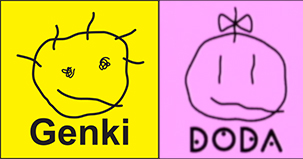
Now that’s branding. Glad to see the 3 year old continued to find success in the industry.
Yeah so anyways I don’t have any good way to wrap this up. All these games are hilariously bad to play, you should just throw the Fist soundtrack on repeat and groove out to those tasty vibes. I was able to, in a sense, avenge my loss to Crimefighter in Pretty Fighter back at Combo Breaker 2015. I took on my friend Perfidious Sinn (@perfidioussyn) at Combo Breaker 2022’s Mystery Tournament and it ended up being Pretty Fighter X. I would not lose to this series a second time, and I sent Perfidious Sinn to losers with my high-level mastery of find-a-sonic-boom-and-abuse-it zoning. Maybe one day I’ll get Fist in Mystery and do the tiebreaker with this damn series.
The VODs for this tournament aren’t up yet, but this happened on stream. The receipts will be out there one day.
Sources:
https://gamefaqs.gamespot.com/snes/575536-seifuku-densetsu-pretty-fighter/faqs/55518
https://gamefaqs.gamespot.com/saturn/575947-pretty-fighter-x/faqs/28760
https://segaretro.org/images/a/a4/Fist_Saturn_JP_Box_Back.jpg
https://gdri.smspower.org/wiki/index.php/Doda
https://gdri.smspower.org/wiki/index.php/Sol_(credits)


